Do I need a plate compacter for pavers?
Have you ever been told to go pound sand? It’s an American idiom with worldwide reach. In some circles, those are fighting words. In paving, it could just be any Tuesday. Proper soil compaction is the key to a firm base. A strong base is necessary to carry heavy loads.
You need a plate compactor for every paving installation project. The most important step in preparing your paving project is compacting the soil before you lay the pavers. If you do not compact the base soil foundation, ground movement will warp your paving over the following years creating humps and hollows. Many professionals also use a compactor on top of the pavers to finish the job. This helps to secure the pavers in place.
Modern building codes require soil preparation before paving. Depending on the type of construction and the geological analysis, you might use a plate compactor or other equipment. Read on to learn more before you start your paving project…
Do I need to use a compactor for pavers?
Without proper compaction, both the sub-base and pavers lack stability, causing shifting over time. If you want your paving project to stand the test of time, proper compaction is essential. If you don’t, you are likely to regret it later as repair and replacement is going to cost more than doing it right the first time!
If you don’t compact your soil base properly, over time you will get humps and hollows in your surface. This is bascially where pavers become higher or lower than others, resulting in an uneven surface. Most people don’t want this as it just doesn’t look that great and create problems with stabilization of patio furniture and the like. But another more important concern is that it creates a range of trip hazards, so safety is a concern.
What is the best material to put under pavers?
There are two basic types of soil for paving purposes, although the Australian agriculture soil system notes more than 50 types. Since you are paving over the soil, the main thing you need to know is that there are two basic types:
Cohesive Soil, which means the soil clumps or holds shape. This type of soil usually contains clay and needs moisture to hold together firmly.
Granular soil is the opposite side of the coin. Particles of sand or gravel make up much of this type. It is loose soil that can’t be compacted, wet or dry. It crumbles when picked up and has no cohesive strength.
Depending on the type of soil you have, you may need to supplement with clay or gravel, add moisture and some sort of structure. After the soils are mixed, you must compact the soil to remove air and space between the soil granules for a firm foundation.
Rammer vs Plate Compactor
Before you go off to find a plate compactor, you want to check if it is the tool for the job. In confined areas where you can’t drive a compacting roller, your choices are a plate compactor or a tamping rammer (jumping jack). They’re hand-operated and easily moved from job site to job site.
How does a plate compactor work?
A vibrating plate compactor uses the repetitive motion to penetrate the soil and move the particles together. The vibrating base plate exerts a downward force in addition to the weight of the machine. In combination, this increases soil density.
A heavy, flat steel plate is attached to an engine that drives the plate up and down. The weight of the machine plus the vibrations of the plate pack the soil tightly together. This pushes air voids trapped in the material to the surface.
How does a Tamping Rammer work?
A tamping rammer produces repetitive blows onto the ground to compact the soil. So it is compacting the soil through sheer force rather than vibrations. Rammers have a smaller plate size than plate compactors and this allows concentrated compaction of stronger soils. This smaller plate size also means that it can be used in narrow areas like trenches.
How to choose your compactor?
A plate compactor and a rammer are the two most common pieces of equipment for light soil compaction. For roads and large earthworks, you use something with more power. Between the plate compactor and the jumping jack, consider your soil type.
The choice between these machines might not be clear. They are both effective in compacting small areas of base material. They produce different results in different types of soil.
What compactor is best for clay soil?
The small, concentrated force of the jumping jack is ideal for narrow trench work and cohesive soils. It is easy to maneuver and focuses energy for deep compaction. They work well to compact cohesive soils because of the size of the plate.
The small plate size allows for focused, direct compaction with harder force than a plate compactor. The machines have a slim, upright design.
Jumping jacks are able to compact a deeper layer of soil than a plate compactor due to their direct force. More fill can be added to each layer, which makes filling and compacting a trench much faster.
Does sand need to be compacted?
Your strategy when working with granular soils like sand and gravel in large open areas is to pass over the area several times. The simplest way to get good density is to make four passes, two each direction.
A plate compactor is the best option. The wider plate size and vibration allow for uniform layers.
Compactor plates are wider than the plate on a jumping jack. In addition, vibrations, no concussive force is used. The weight and compaction force is spread over a greater area.
Because of the way they are designed and operated, plate compactors are better for larger, flat surface areas. Vibrating soil into place allows time to settle and works well in dry and sandy soil.
How much will pavers settle after compacting?
Properly prepared soil prevents foundation cracks, premature wear, settling, and breaks. Depending on the types of soils, you may need both a plate compactor and a jumping jack to create the correct level of compaction.
If you prepare your substrate properly with thorough compaction, your pavers will not settle after compacting. A properly installed paver driveway will still be flat after five years. As with most things, careful planning and preparation is important. Do it right or don’t do it all.
Can I use a plate compactor on pavers?
Another common practice is to use a vibratory plate compactor (not a rammer) on top of the pavers to press them into the foundation. But don’t be mislead, using a compactor without something to protect your pavers is not a good idea. It could result in breaking and scratching your beautiful work.
The best way to do this is to attach carpet or a rubber mat to the base plate of your mechanical plate compactor. Then once the pavers are laid on your compacted sub-base in the pattern of your choice, you can do two to three passes with the compactor on top of the pavers. After each pass, sweep in more jointing sand, and then continue compacting.
Your Paving Compactor
Most paving professionals encounter both of these soil conditions so often it is best to have both options. Alternatively equipment rental is an option.
Both machines are portable, reliable and have long lifespans with proper care. So it is more economical to purchase the machines to have them ready to use.
Don’t depend on consumer-level DIY stores to find professional-level tools and equipment like a plate compactor. Look for local speciality retailers who have a quality product range.
Where Do You Find a Plate Compactor for Sale?
A local construction store with trade experience is best as they have the knowledge of the soil types you are likely to come across in the area. They also work with professionals sourcing their machinery on a daily basis, so have probably got a fair amount of knowledge of the pros and cons of each brand.
Look for well-known equipment brand names like Bartell instead of no-name machinery for the best performance and most comprehensive warranties.
Ready to add a plate compactor to your equipment fleet? Why don’t you take a look at our plate compactors for sale. We also have a range of quality tamping rammers for sale.
If you’re doing a landscaping project and are eager to learn more, check out our article on “How to Lay Bricks”





I’m excited to find this website. I wanted to thank you for your time due to this wonderful read!! I definitely really liked every part of it and i also have you book-marked to see new stuff in your web site.